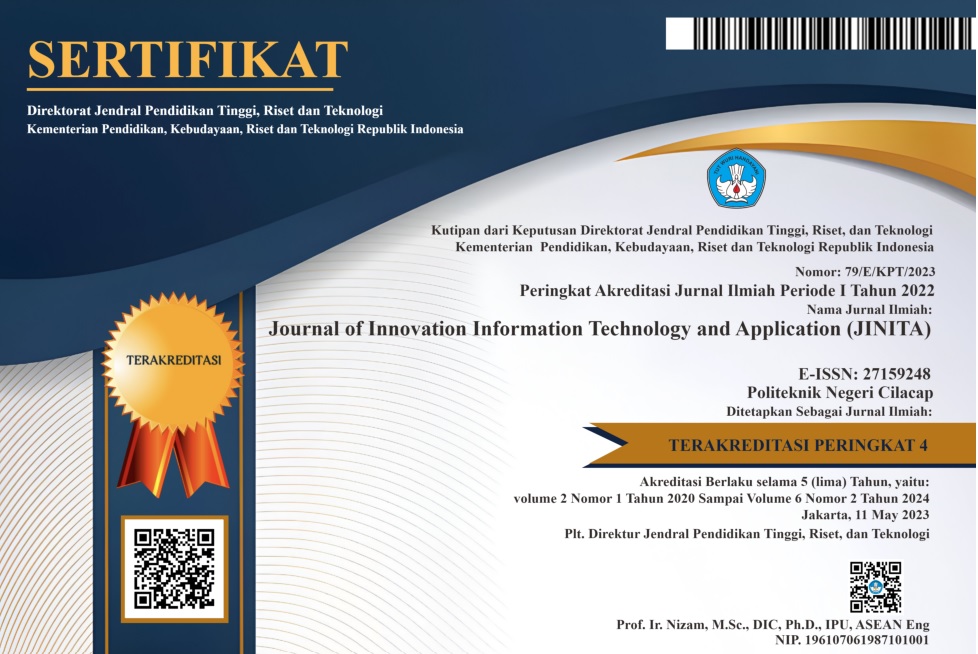Monitoring System for Hazardous Gas in Landfill Site Based on Internet of Things
 Abstract views: 277
,
Abstract views: 277
,
 PDF downloads: 299
PDF downloads: 299
Abstract
The landfill is a place where waste reaches the last stage in its management since it began to arise in the source, collection, transportation, processing, and disposal. Muara Fajar landfill is one of the landfills in Pekanbaru City whose garbage increase exceeds the capacity of waste storage land so that it can produce 800 tons of garbage per day in dry weather and 1000 tons per day in rainy weather. The problem caused by the management of the Muara Fajar landfill is air pollution due to the process of decomposing organic matter anaerobically which has the potential to cause unpleasant odors and health problems. With this problem, a system was built to monitor and detect hazardous gases in landfill, namely H2S gas using MQ-136 sensors, CH4 gas by MQ-4 sensors, and CO2 and NH3 gases using MQ-135 sensors. This system is implemented with the IoT protocol, MQTT Broker to receive and send monitoring data to the Website with notifications from the telegram web application. Based on testing the value of ppm in CO2 Gas with a danger status of 1000-4000 ppm, H2S Gas is 10-400 ppm, NH3 is included in the status of be careful which is 0.03 ppm, and CH4 with normal status because the value of ppm levels is below 10000 ppm
References
Maria Ulfa Trie Jayan, “ Pengelolaan Sampah di Indonesia”, https://www.djkn.kemenkeu.go.id/kpknl-lahat/baca-artikel/14891/Pengelolaan-Sampah-di-Indonesia.html, (accessed Dec. 11, 2022).
S. Sukaridhoto, “Bermain dengan Internet of Thing dan Big Data”, Politeknik Elektronika Negeri Surabaya, 2016
Agam Sanjaya I.P, M.S. Hendriyawan A., “Rancang Bangun Sistem Pemantauan dan Manajement Sampah di Kawasan Perkotaan Menggunakan Internet of Things”, Universitas Teknologi Yogyakarta, 2017.
S. Sukamto, “Perancangan Sistem Monitoring Gas Hasil Pengolahan Sampah,” JEECAE (Journal Electr. Electron. Control. Automot. Eng., vol. 2, no. 2, pp. 121–126, 2017.
G. K. Bhasworo, F. Rofii, and F. Hunaini, "Perancangan Sistem Pemantauan Gas dan Peringatan pada Ruangan melalui Jaringan Nirkabel," TEKNIK, vol. 38, no. 2, pp. 81-91, Dec. 2017. https://doi.org/10.14710/teknik.v38i2.15073.
Fathur Zaini Rachman, “Sistem Pemantau Gas di Tempat Pembuangan Sampah Akhir Berbasis Internet of Things.”, Jurnal Teknologi dan Sistem Komputer, vol. 6, no. 3, pp. 100–105, 2018. doi:10.14710/jtsiskom.6.3.2018.100-105, 2018.
T. A. A. P. Raharjo, S. R. Akbar, dan R. Primananda, “Sistem Monitoring Volume Dan Gas Sampah Menggunakan Metode Real Time Operating System (RTOS)”, J-PTIIK, vol. 2, no. 11, pp. 5651–5658, Jul 2018.
S. C. ABADI, N. W. NUGRAHA, and S. AMINAH, “Implementasi Wireless Sensor Network pada Sistem Manajemen Gedung Menggunakan Protokol Komunikasi Modbus TCP,” ELKOMIKA: Jurnal Teknik Energi Elektrik, Teknik Telekomunikasi, & Teknik Elektronika, vol. 10, no. 3, p. 514, Jul. 2022, doi: https://doi.org/10.26760/elkomika.v10i3.514.
D. P. Dwi Prasetyo, I. L. Ibrahim Lamada, and W. N. A. Wilma Nurrul Adzillah, “Implementasi Monitoring Kualitas Udara menggunakan Sensor MQ-7 dan MQ-131 berbasis Internet Of Things”, ELE, vol. 15, no. 3, pp. 239-245, Sep. 2021.
Marco Schwartz, “ESP8266 Internet of Things Cookbook”, New York: Packt Publishing Ltd, 2017.
Kominfo8/RD2. “Pemko Pekanbaru Kaji Kerjasama Dengan Swasta Olah 750 Ton Sampah di TPA Muara Fajar”. https://www.pekanbaru.go.id/p/news/pemko-pekanbaru-kaji-kerjasama-dengan-swasta-olah-750-ton-sampah-di-landfill-muara-fajar (accessed Dec. 11, 2022).
Copyright (c) 2023 Sugeng Purwantoro E.S.G.S, Wenda Novayani, Raviqa Sandra Putri

This work is licensed under a Creative Commons Attribution 4.0 International License.
Authors who publish with this journal agree to the following terms:
- Authors retain copyright and grant the journal right of first publication with the work simultaneously licensed under a Creative Commons Attribution License that allows others to share the work with an acknowledgement of the work's authorship and initial publication in this journal.
- Authors are able to enter into separate, additional contractual arrangements for the non-exclusive distribution of the journal's published version of the work (e.g., post it to an institutional repository or publish it in a book), with an acknowledgement of its initial publication in this journal.
- Authors are permitted and encouraged to post their work online (e.g., in institutional repositories or on their website) prior to and during the submission process, as it can lead to productive exchanges, as well as earlier and greater citation of published work (See The Effect of Open Access).
















